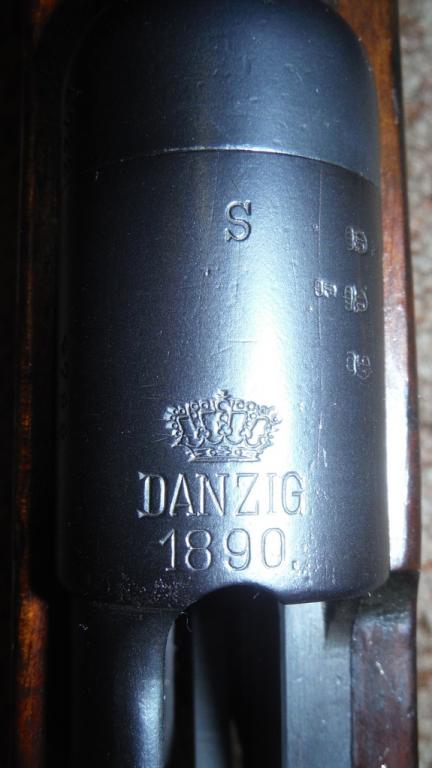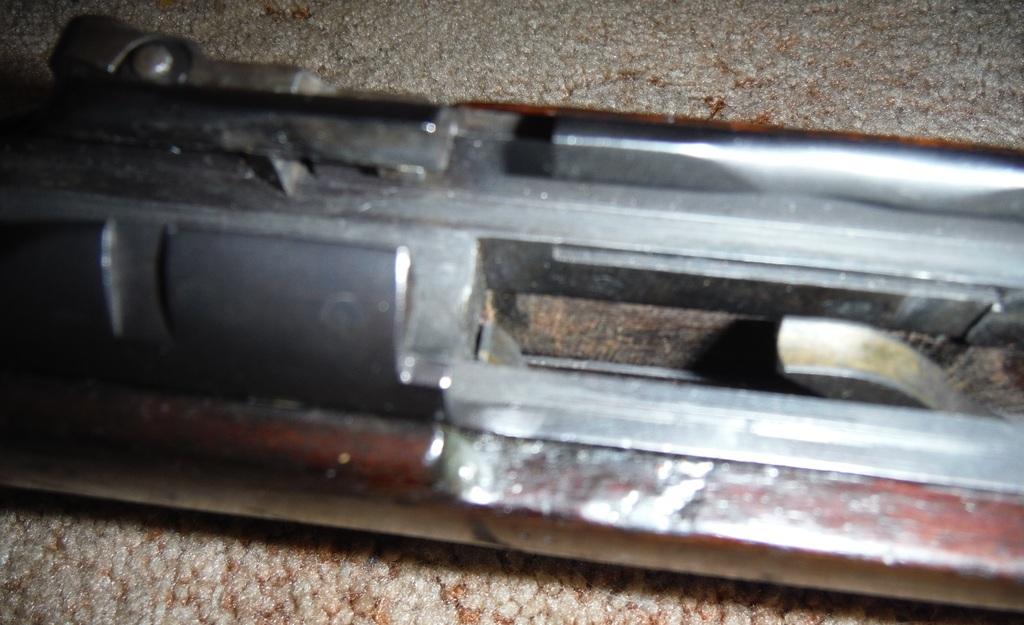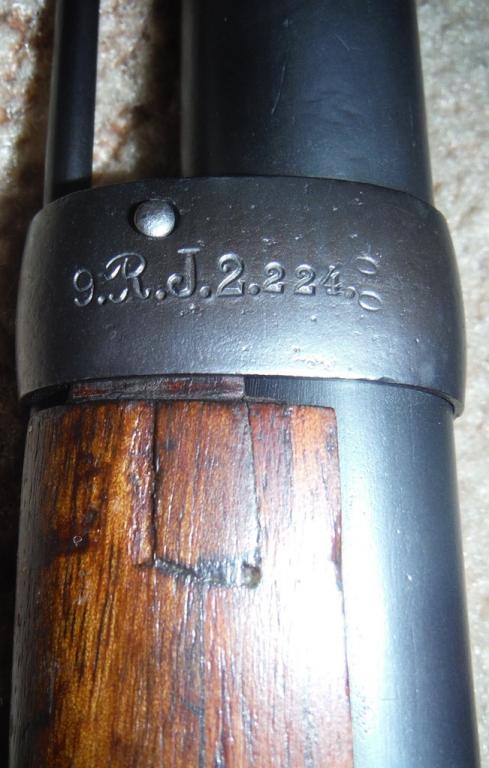-
Legacy Member

1888 Commission Rifle
Hi all,
Just wanted to share with you all my latest acquisition. It is a 1888 Commission rifle. I am really not sure what to call this particular model as it is a bit odd.
When I bought it I kinda jumped on it quickly as I thought it was a 1888'S' rifle (the variant which the 1888/05s were made out of and is also fairly rare as most were converted to 88/05s or 88/14s). Due to some pictures that only showed the receiver and the whole rifle, and the fact that it used the mannlicher clips still I thought it was a simple decision.
Well I have it now, and it is a Turkish 'capture' rifle (wasn't advertised as one, however they didn't say it wasn't either), and it is a complete mismatch (only part that isn't is the barrel jacket and receiver). That all being said, I am still happy with it and I still paid a reasonable price for it.
'capture' rifle (wasn't advertised as one, however they didn't say it wasn't either), and it is a complete mismatch (only part that isn't is the barrel jacket and receiver). That all being said, I am still happy with it and I still paid a reasonable price for it.
Now for the questions. This particular rifle was at one point a 88/05 rifle, which was then reconverted back to using mannlicher clips, by removing the charger guide, and the round holder (magazine lip?) from the receiver. The Turkish, apparently much preferred the standard 88/05 configuration as they would rather have the rifles using the same stripper clips as their Mausers. Would this conversion have been done by the Turks or by someone after being sold on the civilian market? It doesn't make much sense for either to do so unless someone wanted a .323 bore rifle with the mannlicher clips, or the Turkish ran out of 88/05 parts in the rebuild process and converted this back to the original configuration because of that.
Also I know the barrel band isn't from this rifle originally, however I am interested in who the barrel band originally belonged to, so if someone would be able to identify the regimental markings that would be great.
Any opinions are welcome, now for some photos




Sorry about the blurriness of the above picture, the intent is to show the cut in the receiver for the magazine round holder.

Information
 |
Warning: This is a relatively older thread
This discussion is older than 360 days. Some information contained in it may no longer be current. |
|
-
Thank You to Eaglelord17 For This Useful Post:
-
01-26-2016 10:40 AM
# ADS
Friends and Sponsors

-
Advisory Panel



Originally Posted by
Eaglelord17

so if someone would be able to identify the regimental markings that would be great.
Done!
The marking on the band corresponds to the Prussian marking scheme as used 1872-1914
(see "Handbuch Deutscher Waffenstempel" p.108)
9.R.J.2.224 = 9th Reserve Jäger-Batallion, 2nd Company, weapon no. 224
Last edited by Patrick Chadwick; 01-26-2016 at 12:08 PM.
-
Thank You to Patrick Chadwick For This Useful Post:
-
Legacy Member

First you are making conclusions based on wrong information . The S has nothing to do with bore size and it does not mean the rifle is a 88 s . Most 88 s rifle were made after the 88/05 conversion. The Turks did not capture any Gew-88 rifles . They were given to them by Germany as war aid from 1916 on and they later bought many more from the Czechs after the war . All the Turk rifles were 88/05 's , they had either the original German .321 groove bore barrels or .323 Czech
as war aid from 1916 on and they later bought many more from the Czechs after the war . All the Turk rifles were 88/05 's , they had either the original German .321 groove bore barrels or .323 Czech made barrels . I have no idea who did that to the rifle , but since it is reblued I would think it was done over here , for what reason you could only guess . Maybe they had an old mag housing ? What is interesting is that you can see the old WELD marks where the charger guides used to be , so much for the guys who claimed they were riveted . A clearer photo would be great , but you should be able to tell in person that there is no rivet there .
made barrels . I have no idea who did that to the rifle , but since it is reblued I would think it was done over here , for what reason you could only guess . Maybe they had an old mag housing ? What is interesting is that you can see the old WELD marks where the charger guides used to be , so much for the guys who claimed they were riveted . A clearer photo would be great , but you should be able to tell in person that there is no rivet there .
-
-
Legacy Member

-
-
Legacy Member

There are 3 main types of Gew-88 rifles , the most common is the Gew-88 -almost all of them will have the S stamp . There was no over pressure problem as the new S ammo was designed to be fired in the 88 , the bullet was .321 dia , the same as the groove size and the throat was already 3x longer from the old P-88 long rn bullet than needed for the much shorter S bullet . All the S means is the rifle was checked to make sure it would chamber the S round . Next was the 88/05 that had the guides for charger loading , a new made rear sight , a thumb notch for loading with the charger , the mag mods , and the receiver notch for the P-88 ammo to clear . The least common of the 3 was the Gew-88 S , it had the original rear sight modified for the S ammo and was marked on the stock . The 88/14 program was upgrade done as needed on what ever rifle type to make it as close to standard . The Turks never used any Gew-88 rifles , only 05's .
---------- Post added at 09:56 PM ---------- Previous post was at 09:53 PM ----------
Also the book will be a waste of time as it was done with no hands on research and just reworks most of the incorrect information that is on the internet . Just like the rivets , like your rifle does not have .
-
-
Legacy Member

So took the rifle out again to take a look at it, and apparently it was riveted not welded, you have to look closely with your eye to see the locations it was pinned on.


-
Thank You to Eaglelord17 For This Useful Post:
-
Legacy Member

That is the circle left from the weld . The guides had holes in them that were filled with weld , the weld eats into the top of the receiver in a circle pattern . If it was a rivet , it would have fallen out when the top was cut off . The hole would go clean through the reciver.
-
-
Legacy Member



Originally Posted by
bob q

The guides had holes in them that were filled with weld , the weld eats into the top of the receiver in a circle pattern
That's known as plug welding, but I don't believe its weld you're seeing. The technology to do this, especially on such a small scale, didn't exist back then. Besides, the spots are too perfectly round for that anyway. The rings around the edges suggest to me they are holes that have possibly been tapped/filled with screws and made off flush.

Originally Posted by
bob q

If it was a rivet , it would have fallen out when the top was cut off .
If they was bucked good they wouldn't. Rivets bodies can be a bugger to drive out.
Last edited by vintage hunter; 01-29-2016 at 11:29 PM.
-
The Following 2 Members Say Thank You to vintage hunter For This Useful Post:
-
Legacy Member


Originally Posted by
vintage hunter

That's known as plug welding, but I don't believe its weld you're seeing. The technology to do this, especially on such a small scale, didn't exist back then. Besides, the spots are too perfectly round for that anyway. The rings around the edges suggest to me they are holes that have possibly been tapped/filled with screws and made off flush.
Just goes to support what everyone has been told for years. I am still curious as to who made it/returned it to this configuration, however tomorrow I intend to shoot it, and depending on the result that will determine how long it sticks around for.
-
-
Legacy Member


Originally Posted by
vintage hunter

That's known as plug welding, but I don't believe its weld you're seeing. The technology to do this, especially on such a small scale, didn't exist back then. Besides, the spots are too perfectly round for that anyway. The rings around the edges suggest to me they are holes that have possibly been tapped/filled with screws and made off flush.
If they was bucked good they wouldn't. Rivets bodies can be a bugger to drive out.
They have not been " bucked good " as there is NO hole on the bottom . They are not screws as it is to thin in that area [ with no hole drilled through ] to get more than about 2 or 3 threads in a blind hole . If you look up welding used in the military in that time frame , it did exist . Also I have knocked the guides off a rifle and they are a weld . The weld was strongest in the hole in the guide [ which makes the circle on the receiver ] and pulled a little piece of the receiver with it, just like in his photo , plus someone cleaned the stop up before they blued it .
---------- Post added at 11:04 AM ---------- Previous post was at 10:58 AM ----------

Originally Posted by
Eaglelord17

Just goes to support what everyone has been told for years. I am still curious as to who made it/returned it to this configuration, however tomorrow I intend to shoot it, and depending on the result that will determine how long it sticks around for.
Back to your original question , who made it and why . It was not mine as I rewelded the guide back on the rifle I worked with . All I can guess is someone tried to make a Gew-88 out of a 05 when Gew-88's were hard to find . If you understand how a rivet works and what a plug weld looks like , your rifle clearly disproves the rivet .
-
'capture' rifle (wasn't advertised as one, however they didn't say it wasn't either), and it is a complete mismatch (only part that isn't is the barrel jacket and receiver). That all being said, I am still happy with it and I still paid a reasonable price for it.
 Information
Information


















 PM
PM










